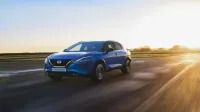Nissan moves the Qashqai upmarket with sharp design, unusual hybrid powertrain

Nissan continued its model offensive by unveiling the third-generation Qashqai, a compact crossover that slots below the Rogue in its global lineup. Designed and engineered in the United Kingdom, the popular soft-roader will likely make its way to the United States in the not-too-distant future as the second-generation Rogue Sport.
Stylists refrained from making significant changes to the Qashqai’s proportions, but they gave its front end a much bolder look that borrows design cues from the bigger Rogue. Its grille is bigger than the outgoing model’s (an ongoing trend spreading across the industry) and it’s flanked by swept-back LED daytime running lights underlined by low-mounted headlights. Chiseled air intakes set the scene for the rest of the crossover’s styling updates.
Launched globally in 2013, the last-generation Qashqai wore rounded lines that were perfectly in tune with the styling trends of the 2010s. Nissan brought the crossover into the 2020s by making it edgier. The character lines that run down both sides are sharper, and the rear lights evolved in a more angular direction. Blacked-out C-pillars create the illusion of a floating roof, a trick borrowed from the Maxima that opens the door to a two-tone paint job.
Nissan made the new Qashqai slightly taller, longer, and wider, and it extended the wheelbase by a little less than an inch. And yet, the crossover is slightly lighter thanks to a number of weight-saving measures such as doors, fenders, and a hood made with aluminum, along with a rear hatch manufactured using composite materials. It’s 41% stiffer, too.
Better materials and more technology are the highlights in the cabin. Upmarket trim levels are offered with massaging seats and a wireless device charger, for example, features once reserved for much more expensive cars. The dashboard houses a 9-inch touchscreen that displays a new infotainment system compatible with Android Auto and Apple CarPlay, and the driver sits behind a 12.3-inch digital instrument cluster that can be configured to display a variety of menus, including navigation (when equipped) and entertainment.
European buyers will have three powertrains to choose from. The entry-level engine is a 1.3-liter four-cylinder that delivers 138 horsepower and 177 pound-feet of torque. It’s exclusively available with a six-speed manual transmission that spins the front wheels. Next up is a 156-horsepower evolution of the 1.3 offered with either a six-speed stick or a continuously variable transmission (CVT), and the two-pedal option can be paired with all-wheel-drive. Both 1.3s receive mild hybrid technology. At the top of the range sits a hybrid system built around a 1.5-liter four. It’s automatic-only, and the system’s total output checks in at 187 horsepower and 243 pound-feet of torque.
Interestingly, the 1.5-liter burns fuel exclusively to generate electricity; it’s not connected to the wheels in any way. It charges a battery pack that zaps into motion an electric motor related to the unit Nissan puts in the Leaf. It’s like driving an electric car without having to worry about range or charging times; there’s even a one-pedal option.
Nissan’s ProPilot suite of electronic driving aids is available on automatic models. It gives the Qashqai the ability to accelerate to a pre-set speed, react accordingly when the speed limit changes, slow down if the vehicle in front brakes, and come to a full stop if needed. It also analyzes navigation data to know when there is a curve or an exit ramp that it needs to brake for. It does not turn the Qashqai into an autonomous car, however.
Across the pond, Qashqai sales will begin in the coming months. Nissan hasn’t confirmed that the model will return to our shores as the Rogue Sport, but we’re expecting an official announcement during the first half of 2021.




